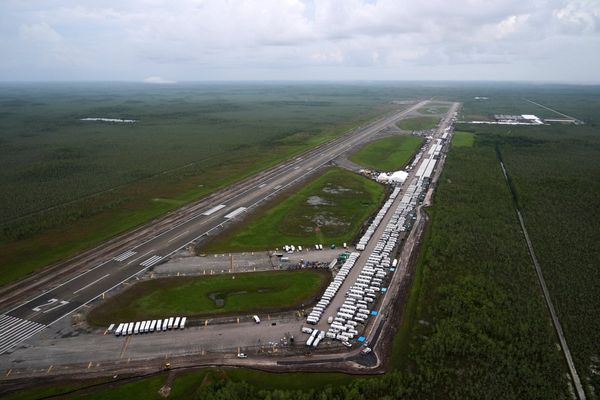
Tulips herald the advent of spring - and the Dutch believe they can also highlight ways to fight climate change.
Thousands of tulips are in bloom this week to welcome visitors to the opening of the once-in-a-decade Dutch horticultural exhibition called Floriade, which seeks to showcase horticultural innovations that can make urban areas more sustainable and healthier as people around the world increasingly shift to cities.
A new university building on the 60-hectare (148-acre) site on the edge of this modern city close to Amsterdam has plants growing from one of its walls, while an apartment block is decked out in huge prints of flowers. It towers over a newly-built cable car and a Corten steel sculpture of two human figures made up of tens of thousands of bees.
Sculptor Florentijn Hofman says he is sending a message about protecting biodiversity.
"The work is about the relationship between bees and humanity, about connection. It’s about equilibrium and a respectful relationship between humans and animals and our complex interrelationship with nature,” he said.
Even the site itself highlights Dutch technical knowhow - it is built on land reclaimed from the sea decades ago. And amid a Dutch affordable housing crisis, the Floriade terrain is envisaged to become a new urban area of 3,000 homes after the expo ends on Oct. 9.
Dutch King Willem-Alexander was opening the event Wednesday. It expects to welcome 2 million visitors as the displays shift through the seasons, from springtime to summer and autumn.
The legacy will be "a very, very green living area, a living arboretum," said Annemarie Jorritsma, a senior Dutch representative at the show. "People are going to live within the nature. And I think it will be a wonderful experience to be able to live here.”
Previous Floriades have been about building parks while this edition is about building a city, says architect Winy Maas, who designed the layout.
"For the first time, this is a Floriade that can become a neighborhood," he said.
More than 25 nations are presenting sustainable ideas during this year's show under the theme "Growing Green Cities." The Netherlands, a world leader in horticulture, has a one-hectare greenhouse where farmers are showing off their newest innovations.
Other countries are blending old and new in their national pavilions - from Qatar's 3D-printed buildings shaped like age-old pigeon towers to China showcasing new uses for bamboo, a traditional building material.
"What I like very much is that China has taken the trouble to do not something traditional, but to use a traditional material - bamboo - for a very modern developments," said Jorritsma.
"So you also can see that ... in China, people are now thinking about what are we doing? How can we change our use of the materials we already have and use them in a very modern way?” she added.







